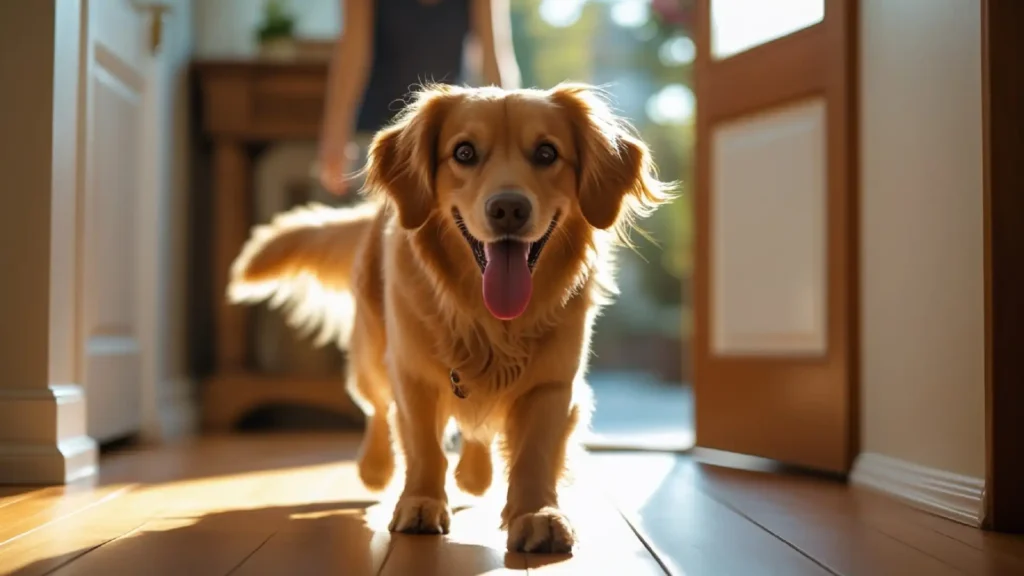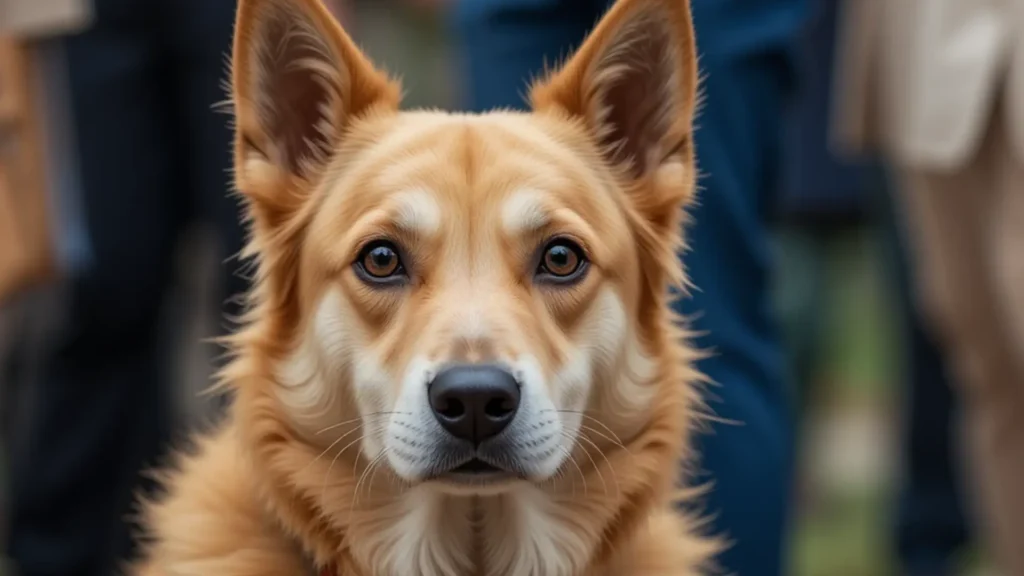Dogs wag tails frequently. It’s a signature part of their body language that often leaves us curious about its meaning. Whether it’s a joyful, enthusiastic wag or a slow, cautious flick, dogs use their tails to communicate a wide range of emotions, intentions, and reactions.
People think wagging tail equals happy dog, but it’s actually a lot more complicated than that.
Understanding the reasons of wagging tails can deepen our connection with our canine companions. This helps us interpret their feelings and respond accordingly.
According to Nicholas Dodman, a professor emeritus at Tufts University, “An upright tail can imply dominance, a horizontal tail can hint at neutrality and a low tail can mean submission.”
Let’s explore the fascinating reasons behind this behavior and what your dog’s tail might be telling you.
Happiness and Excitement: The Classic Wag
Dogs wag their tails to express happiness or excitement. This is the primary reason fo tail wagging. According to Giulia Cimarelli of the University of Veterinary Medicine Vienna, “This behavior as a whole is communicative.”
According to Silvia Leonetti, a research assistant in comparative bioacoustics at the Max Planck Institute for Psycholinguistics, “Tail wagging is frequently associated with some sort of arousal, be that positive or negative. It may be correlated with arousal-related hormones and neurotransmitters in the dogs’ bodies.” They cited indirect evidence linking oxytocin, the “love” hormone, and tail wagging, especially when dogs are reunited with their owners.
How do you understand that your dog is wagging tails to express happiness?
If you’ve ever seen a dog greet its owner with a wild tail wag, you’re witnessing pure joy. When dogs are thrilled to see someone they love, their tail wags energetically from side to side. The speed and force of the wag usually increase when the dog is really excited, and their body might even move in rhythm with the tail.
In these moments, the tail is often held at a neutral or slightly elevated position. Dogs may wag their tails when playing with other dogs, seeing familiar places, or anticipating something enjoyable, like a treat or a walk.
Friendly and Approachable: A Sign of Acceptance

Tail wagging is also an indicator of a dog’s friendly demeanor. Dogs wag tails in a relaxed manner to say that they aren’t threats. They make their posture loose and relaxed to offer friendship. It occurs when the dog is approaching another animal or person.
In these cases, the tail might wag slowly but gently. The dog’s posture will be loose and non-threatening. If a dog is wagging its tail in a calm manner and seems open to interaction, it’s a clear sign that they are approachable and would likely enjoy a friendly exchange.
Confidence and Dominance: Tail Held High
Wagging tails is visible at a distance. Dogs wag their tails to dominate other dogs. They do it to express their confidence. This is often seen in situations where a dog is asserting itself. Veterinary physiologist Federica Pirrone at Italy’s University of Milan suggests that tail-wagging in dogs is similar to gesturing during human speech.
A dominant dog holds its tail high and wag it slowly.
This type of wagging sometimes come across as more deliberate and controlled, signaling that the dog is not intimidated by its surroundings and is comfortable in its space. While this behavior is normal in some contexts, it’s important to understand that this tail posture, when paired with other body language signals like standing tall or stiffening its body, can sometimes indicate aggression or territorial behavior.
Fear and Anxiety: A Low or Tentative Wag
Not all tail wagging indicates positive emotions. When a dog is anxious, fearful, or uncertain, it might wag its tail in a different way. The tail may be held low and wagged slowly, often accompanied by other signs of stress such as tucked ears, avoidance of eye contact, or cowering posture. This tail wag suggests submission or insecurity and indicates that the dog may be feeling threatened or uncomfortable.
Dr. Brittany Grenus, a veterinarian says that, “If a dog has their tail tucked tightly between their legs and is wagging the tip in a tight fast motion, this is typically indicative of the dog experiencing a fear response.”
For example, dogs can show this type of signal to express some sort of insecurities in front of an unknown person. Similarly, they can do this when feeling nervous about a loud noise or new environment. This type of wag is a sign to approach with caution and allow the dog to feel comfortable and safe in its space.
Aggression or Warning: The Stiff, Slow Wag
Sometimes, a dog’s tail wag can be a warning rather than an invitation. When a dog feels threatened or is preparing to defend itself, it wag its tail slowly, often in a stiff, rigid manner. This is commonly seen in aggressive situations, when the dog’s body language indicates that it is ready to take action if necessary. The tail may be held straight or even slightly raised, and the dog’s posture will be tense.
Stanley Coren, Ph.D, a professor of psychology at the University of British Columbia, explains, “The tail’s position, specifically the height at which it is held, can be considered a sort of emotional meter. A middle height suggests the dog is relaxed. If the tail is held horizontally, the dog is attentive and alert. As the tail position moves farther up, it is a sign the dog is becoming more threatening.”
In these moments, the tail wag is often a sign of conflict or aggression, and it’s a clear warning that the dog may become defensive or react aggressively if it feels its space is invaded. Dogs that exhibit this type of wag are often telling others to stay away, as they are not comfortable with the situation. Avoid the dogs in this situation, because there is likely that they will take an attempt to bite you, if you approach them.
Curiosity and Attention: The Investigative Wag
Dogs are naturally curious creatures, and they often use their tails as a tool to communicate their interest or attention. When a dog is investigating something, such as a new object, person, or scent, it may wag its tail slowly and with focus. This type of wag indicates that the dog is intrigued but may still be cautious or assessing the situation.
In these cases, the tail movement is more deliberate and reflective of the dog’s concentration. The wagging is not as fast or exuberant as it would be during play or excitement, but it’s a subtle sign that the dog is paying attention to something important. If the dog’s body posture is relaxed, it suggests curiosity without any real sense of threat.
Understanding the Full Picture: Tail Wagging and Other Body Language
While tail wagging is an important part of how dogs communicate, it’s just one aspect of their overall body language. To fully understand what a dog is feeling, it’s essential to look at other signals, such as ear position, facial expressions, and posture.
Dr. Camille Alander, a veterinarian with NYC’s Bond Vet, “Tail wags are kind of hard to read.”
A tail wag can mean different things depending on the context, and other body language cues can help clarify whether the dog is happy, nervous, dominant, or fearful.
For example, a dog wagging its tail while also showing bared teeth or a stiff body may not be as friendly as a dog wagging its tail with relaxed ears and a wagging body. Similarly, a dog wagging its tail with a crouched posture might be indicating playfulness, while a raised hackle and a stiff tail could signal that the dog is feeling threatened.
Dogs use their tails to communicate a complex range of emotions. Understanding the nuances of tail wagging can help us interpret our dogs’ moods and intentions, fostering better communication and stronger bonds. With a little practice, you’ll be able to read the tail’s signals and better understand what your furry friend is trying to tell you.




